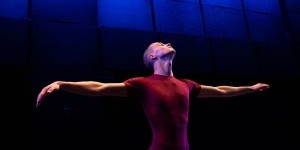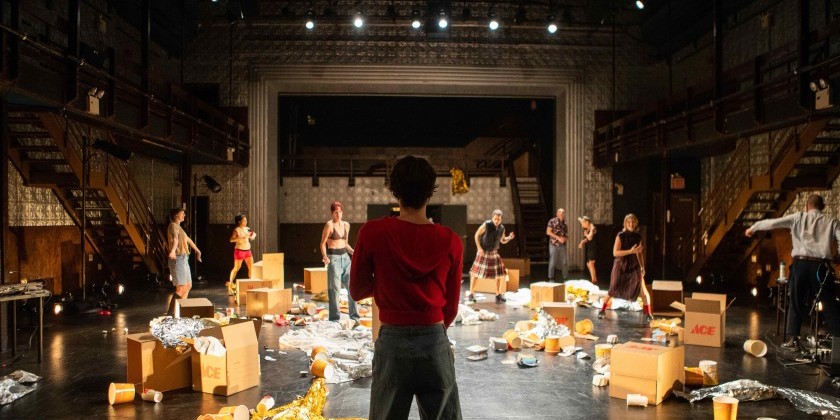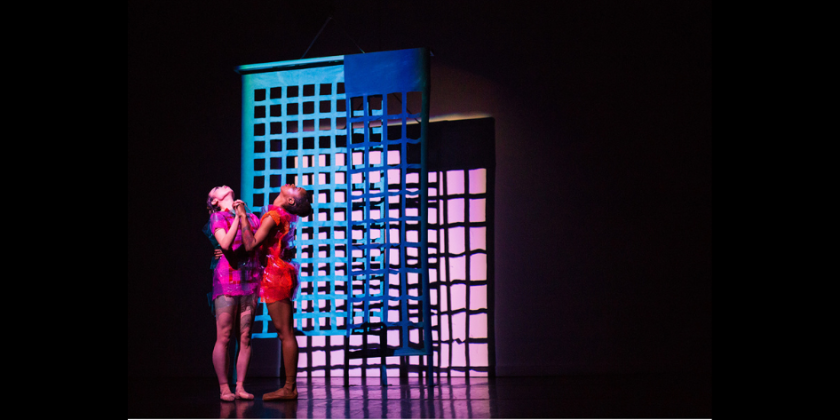IMPRESSIONS: "Cloud Study" by John Scott at the La MaMa Moves Dance Festival

Performers: Mufutau Yusef, Jamie Scott (understudy for Taryn Griggs)
Music: Ryan Vial
Lighting: Eric Wurtz
Assistant Choreographer and Costumes: Justine Doswell
Performance Date: Sunday, May 1, 2022 @ 4pm
Jamie Scott strolls into “The Downstairs Theatre” at La MaMa, picking up a microphone that lies on the ground. After a moment of silently absorbing the audience, she introduces herself. “The first thing that I ever did on stage was this,” she explains, showing us a scooch-ey, kick-ball-change. “It was in a high school auditorium in Fairfax, Virginia.”
As Scott continues to present herself in this easy, convivial manner, Mufutau Yusuf, a force of nature, enters, circling the space as though desperately chasing something beyond the horizon.

This is John Scott Dance’s “Cloud Study,” just one of the bold, innovative productions presented during the 17th season of La MaMa Moves. An innovator of modern dance in Ireland for many years, Scott founded the Irish Modern Dance Theater in 1991, changing the name to John Scott Dance in 2016. The use of dancers from different cultural backgrounds, speaking different languages, has been a constant in his work.
“Cloud Study,” first presented in 2018, oscillates between moments of powerful physicality and vulnerability. Like clouds, the movement dissolves, then reappears. It can be carefree and meandering, or carry the intensity of an epic storm. Yusef has been in the cast since the work’s premiere, but the role played by Jaime Scott, (no relation to the choreographer) has been occupied by several different dancers. Early in the piece, Scott informs us that she stepped into her part after getting a call the day before this show.

Often, Yusef and Scott move side by side in variations on a similar theme – a gesture of the upper body might translate into the legs, or an upright passage might be transplanted onto the floor. Much of the movement is based in running. The simplicity of this pedestrian movement lays the groundwork for more complicated physicality later. Contrasting textures swirl: actions can float with airy lightness, whip and whirl with abandon, or carry the weight of a cloud laden with rain.

The dancers speak in English, Yoruba, and in a particularly charming moment, Scott recites her multiplication tables in Japanese, explaining apologetically “I don’t have a lot of language proficiency, but I did study Japanese as a kid.”
We wonder how to respond to words in a language we don’t understand. We search for meaning in the quality of delivery, the tone, and the volume. The incorporation of different languages makes us feel as though we, like clouds, can effortlessly teleport to faraway lands. The quality of each language carries with it the intrigue of encountering a new culture.
At times when the dancers speak in English, they strip away any previously understood meaning behind the words. Yusef brings out a chair, sits down, and repeats words in English that increase in speed, becoming impossible to understand; the words themselves lose meaning and turn into abstractions, gestures of the mouth producing sound.

While Scott frequently communicates with the audience in words, Yusef expresses himself most often through sensitive physicality. There is weight and intentionality behind every gesture. Each movement, down to the tiniest flinch of facial muscle, has meaning. Yusef’s performance is one of the most compelling aspects of the piece.
It’s not clear how much, if any, of “Cloud Study” is improvised, but the dancers strike a delightful balance between deliberate and spontaneous. A score by composer Ryan Vail featuring everyday sounds and orchestral textures offers a gentle and subtle undertone to the work, although much of the movement takes place in silence. This requires the dancers to be incredibly conscious of one another - impressive, especially considering their short amount of rehearsal time together!

Jamie Scott and Mufutau Yusuf in " Cloud Study" choreographed by John Scott; photo by Steven Pisano
The final image resonates: Yusef and Scott walk slowly backwards, flinching and shielding their faces as if moving away from the bright light of the sun. As the lights go out, we feel as if we are emerging from a complex and provocative dream.












